As a geosynthetics buyer or wholesaler, you may be wondering about the differences between geogrids and geonets. It’s essential to understand how they are similar and how they’re different in order to make the right purchase for your project. But never fear – this article is here to explain these two types of products in detail!
An obvious similarity between these two products is that both are used in applications like stabilizing soil, embankments, grids, beams, and columns. You’ll still need to understand the differences, however – will a stronger strength or flexibility be more important in your task? Different solutions like intersecting rib bead geogrids or knitted monofilament polyester (or polypropylene) geonets offer key benefits for particular projects. Once you’ve got an idea of what each type offers best, making your ultimate decision should become much clearer.
It’s important to remember that both high-strength geogrids and ultrahigh molecular-weight polyethylene mesh rolls have unique features. When you break down the details into categories such as flexibility, stability, and porosity control factors – all of which can affect pricing too – it will help make the purchase decision far simpler. After understanding the nitty gritty about geometric composition, non-flammability standards for construction areas, and bend radius strength capacities (for example), choosing between these materials should become much easier.
What Are Geogrids and Their Uses?
Geogrids are geosynthetics that work in a wide range of geotechnical stabilization applications. They consist of a matching set of tensioned, interconnected grid elements formed by several parallel lateral bands arranged in a geometrical pattern. Geogrids are widely used to improve the bearing capacity and stability of roads, railways, embankments, and earth retaining structures, to facilitate geostructural reinforcement for slopes and seepage control for earth dams. They also function as separate layers for the protection of geomembranes from geotextiles tear in construction landfill filling operations. In more advanced applications, geogrids can be used for interacting with soils to form an efficient geocomposite wall system that is able to retain soils in steep slopes or deep excavations.
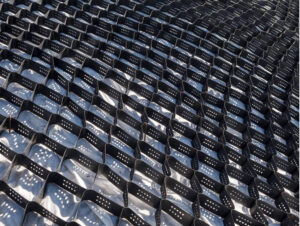
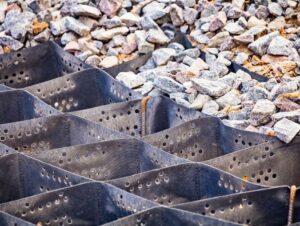
Geogrids offer several benefits over traditional methods of soil reinforcement. For example, they can be used in areas where traditional methods (e.g., concrete or steel) might not be feasible due to environmental constraints or cost considerations. Additionally, geogrid-reinforced structures require less maintenance than those reinforced with traditional methods because they can stretch without breaking or cracking over time, which means that there is less need for repairs or replacement down the line. Finally, using geogrid for soil reinforcement can reduce the number of materials needed for a structure by up to 60% compared to using traditional reinforcement methods alone.
Types of Geogrid Materials
From projects built on slopes to ones involving water containment, different types of geosynthetic materials can be employed depending on environmental factors specifically tailored to the project site at hand. Temperature range and pH levels should also be taken into consideration when selecting geogrids for various applications.
Commonly used geosynthetic materials include polyester (PET), polyethylene (PE), polypropylene (PP), high-density polyethylene (HDPE), aramid fibers (Kevlar), glass fiber (GF), and carbon fiber (CF). Depending on your particular project’s specific needs, one material may prove more optimal than another. That’s why it’s so important to discuss your options with a trusted supplier beforehand so you can make an informed decision when purchasing the necessary materials for your project.
Geogrids come in two primary forms – uniaxial (UBG) and biaxial (BBG). Uniaxial geogrid is most commonly used for reinforcement applications where there is only one direction of stress on the grid. This type of grid has a single layer of woven fibers and has excellent tensile strength but limited stiffness when compared to biaxial geogrids. Biaxial geogrid consists of two layers of fibers and is designed to provide both tensile strength and stiffness in both directions along its surface.
The Pros of Using Geogrids
Geogrids have many advantages that make them ideal for certain applications. For starters, they are very durable and can withstand high levels of pressure without tearing or breaking. This makes them perfect for reinforcing soil around structures like roads, retaining walls, bridges, and even buildings. Additionally, geogrids are highly effective at reducing settlement or subsidence of the soil below them. This means that geogrid-based structures tend to last longer than those without them due to reduced erosion and other factors that can be damaging over time.
Geogrids are also cost-effective compared to other types of reinforcement materials such as steel bars or concrete blocks. When compared to traditional methods of reinforcement, geogrids can provide similar strength at a fraction of the cost. Finally, they are easy to install since no specialized equipment is needed—a simple spade is all that’s required!
The Cons of Using Geogrids
As with any material, there are some downsides to using geogrids as well. For one thing, they can be difficult to remove if you need access to the area beneath them—especially if it was originally installed by hand rather than with machinery. Additionally, depending on the application, geogrid installations may require additional drainage measures such as gravel beds or French drains in order for them to work properly—which adds even more cost and effort to the project overall. Finally, some types of geogrid require special care when handling due to their fragile nature, this includes being mindful during installation so that they don’t get damaged or break apart before being laid down in place.
Geogrids offer many advantages for certain civil engineering and construction projects but also come with some drawbacks depending on the application in question. If you’re considering using geogrids for your project then make sure you weigh up the pros and cons carefully before making a decision! With proper research and planning, however, you should be able to create a structure that will stand the test of time thanks to its reinforced foundation provided by these versatile materials!
Overall, understanding the basics of what geogrids are is key when purchasing this versatile product – especially if you plan on buying or wholesaling them for commercial use in civil engineering projects such as road construction or landfills. With its lightweight design yet strong durability against earth movements like landslides or earthquakes, its flexibility allowing it to stretch rather than break, low maintenance requirements, and reduced material costs – it’s no wonder why more people are turning toward using geogrid technologies in their projects across varying industries! Whether you’re buying large quantities as a wholesaler or just need enough for your small DIY project – don’t forget all the advantages that come with purchasing quality geo-grids like these!
Something You Need To Know About The Geonets
Geonets are geomaterials composed of a netted structure made from synthetic or natural fibers. They are commonly used in geotechnical applications, particularly for retention and containment systems. This is because geonets offer excellent drainage and filtration capabilities, allowing excess water to be discharged through their mesh-like material. In addition, geonets can reinforce soils, helping to reduce the risk of geotechnical failure in areas prone to heavy rains or flooding. Other common uses for geonets include reinforcement for paver patios and walkways, geotextile applications such as road base reinforcing, retaining walls, soil separation, and erosion control. With the varied applications of geonets, they are an important tool in technology.
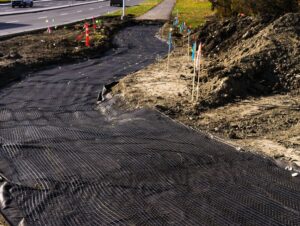
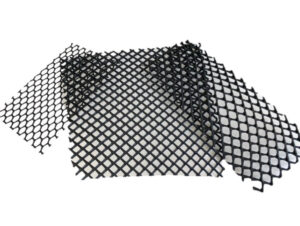
Geonets’ Versatility
One of the main benefits of geonets is their versatility. They can be used in a variety of situations, including water management, erosion control, filtration systems, and other applications where strength and stability are needed. For example, they can be used to create retaining walls or as part of a drainage system. The cells provide more surface area for water to flow through than traditional materials like gravel or sand. This allows water to move faster through the system without clogging or backing up.
In addition to being versatile, geonets also offer excellent strength and stability compared to other materials with similar properties. Their honeycomb structure provides additional strength when placed under pressure or on load-bearing surfaces like roads and bridges. This makes them ideal for use in areas where heavy vehicles need access but ground stability needs to remain intact over time.
Uses Of Geonets
Geonets have many uses across different industries including civil engineering projects such as roadways, bridges, dams, oil & gas pipelines, landfill containment, roofing insulation, wastewater treatment systems, and agricultural irrigation systems. In each application, they help improve structural integrity while providing excellent drainage capabilities that allow water or liquid waste to move quickly through the system without clogging it up or creating pressure points that could damage the structure over time. Additionally, because they are made from HDPE they resist corrosion which helps them maintain their structural integrity even in harsh environments or climates where traditional materials may not last as long. This makes them an ideal choice for those looking for a strong yet durable material for their project needs.
The Pros of Geonets
Geonets are made from a type of synthetic fabric that is designed to be breathable, waterproof, mold-resistant, insect-proof, fire-retardant, resistant to ultraviolet (UV) radiation, and able to withstand extreme temperatures. These features make Geonets an ideal material for use in a variety of applications such as roofing, foundations, walls, basements, driveways, patios, decks, walkways, poolside, and more. In addition to their durability and versatility in application areas, Geonets can also last up to 50 years if maintained properly throughout their lifespan.
The Cons of Geonets
Perhaps the most significant disadvantage associated with geonets is their cost. While they may be more affordable than other materials in the short run due to their longevity they can become costly over time if not maintained properly. Additionally, installation requires specialized knowledge which means that it may be difficult for homeowners or businesses without experience installing geonet systems to do so on their own. Finally, while they are durable they can still suffer from occasional punctures or tears which could lead to further water damage if not attended to quickly enough.
In a word, geonets are an incredibly versatile material with a wide range of uses across multiple industries from civil engineering projects to wastewater treatment systems. They offer excellent stability under pressure as well as superior drainage capabilities compared to more traditional materials like gravel or sand due to their honeycomb cell structure which provides more surface area for liquids to flow through quickly without clogging up the system or creating dangerous pressure points that could damage the entire structure over time. As a geonet wholesaler, you can rest assured knowing you have an effective product on hand that is sure to meet your customers’ needs no matter what type of application they need it for!
The Differences Between Geogrids and Geonets
Geogrids and geonets are essential to many civil engineering projects as they help stabilize soil and protect against landslides, erosion, and other environmental damage. These geosynthetic materials are generally made from plastic or metal, with geogrids typically being composed of plastic and geonets using either material. The decision to use one or the other ultimately depends on the application of the product in question – for example, metal may be better if the project involves very high compressive forces that require extra reinforcement. In any case, geogrids and geonets have become invaluable assets for many engineering applications and can help boost the strength and durability of almost any structure.
Geogrids and geonets are commonly used in civil engineering applications and have different features that suit different needs. Geogrids have the advantage of being available in a variety of sizes and shapes, which makes them perfect for projects such as reinforcing retaining walls and slope stabilization. On the other hand, geonets are typically only available in one size and shape. They are ideal for drainage applications due to their geotextile connectivity. Together geogrids and geonets can provide engineers with all the options they need to complete even the most challenging geotechnical projects.
Geogrids tend to cost more upfront than geonets, but they are a more economical choice in the long run. This is because geogrids can be reused multiple times, making them a cost-effective option for large projects. Additionally, geogrids tend to last longer than geonets, this increases their value over time as they are not needing to be replaced often. Geonets are still useful in certain applications, but when looking for something more durable and reusable, geogrids have a clear edge.
Conclusion
To conclude, both geogrids and geonets are essential tools used in civil engineering projects. Geogrids provide strength and durability for large-scale projects, whereas geonets offer excellent drainage capabilities for retaining walls and soil separation. The decision of which material to use ultimately depends on the application while geogrids may be more expensive upfront, they tend to last longer and can be reused multiple times due to their increased longevity and reuse potential. Constructed of geosynthetic material, geogrids are designed to optimize load distribution and soil reinforcement in civil engineering projects – making them highly durable and a great investment for applications such as retaining walls, embankments, and erosion control. In short, geogrids can yield many immediate and future benefits, such as reduced construction costs and site disturbance, that far outweigh the initial costs associated with them.
Author

Founded in 2002, Tinhy's team focuses on the manufacturing, marketing, installation, application and research and development of geosynthetic materials.
View all posts

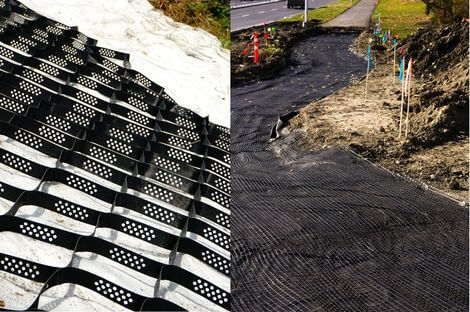




1 thought on “What Are The Differences Between Geogrids And Geonets?”
Nice to read your blog regarding geogrid and geonets.